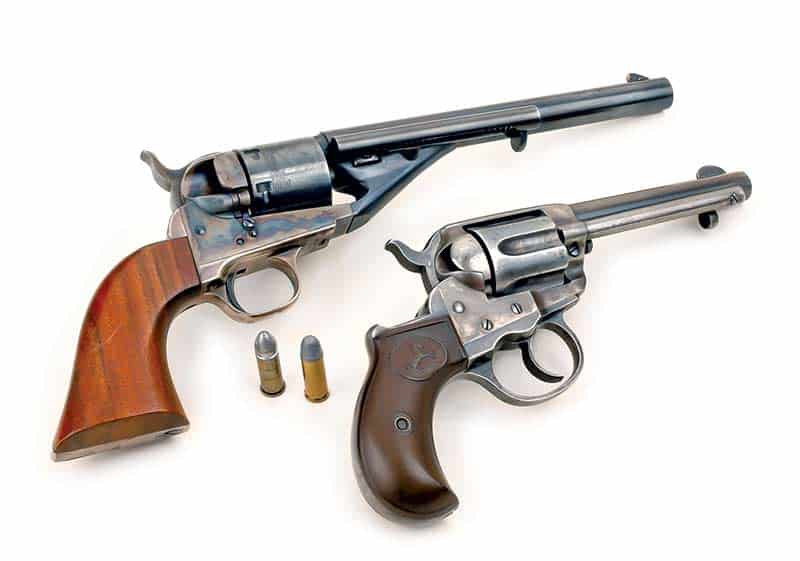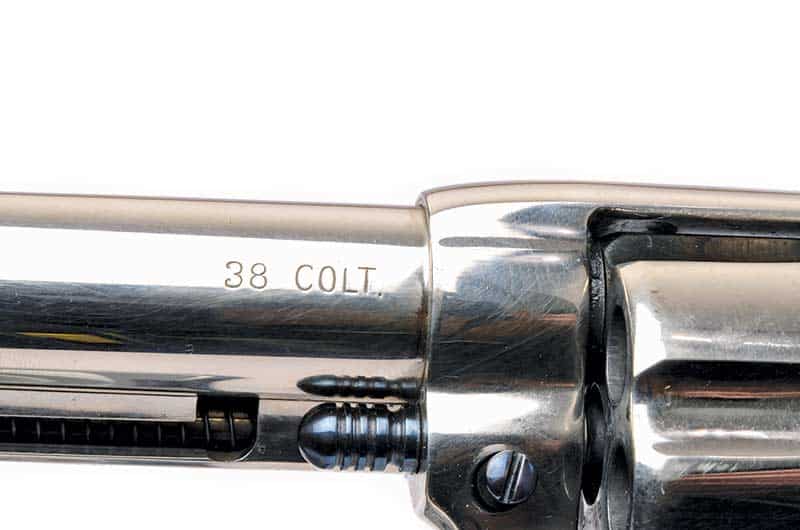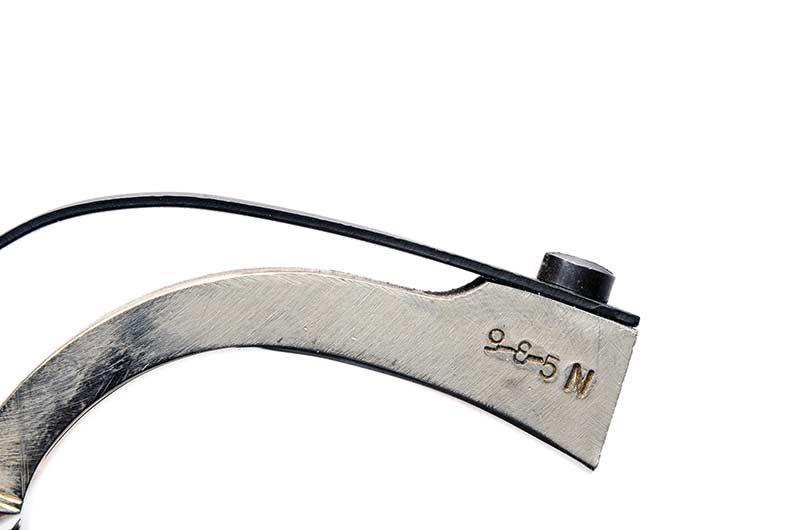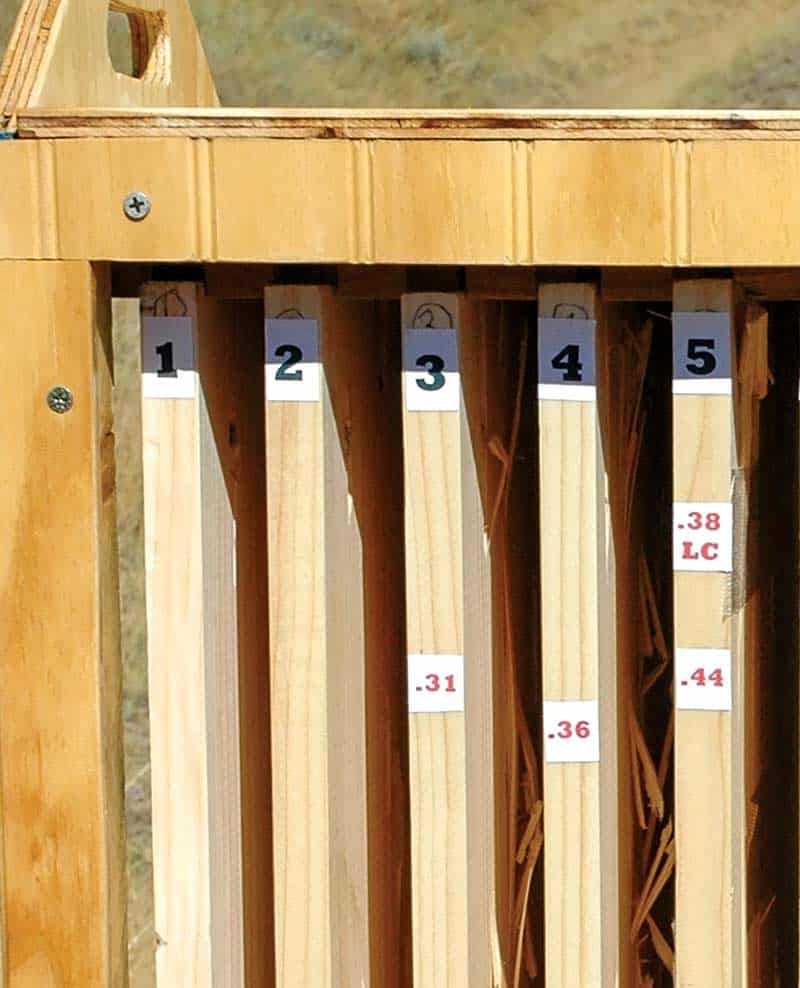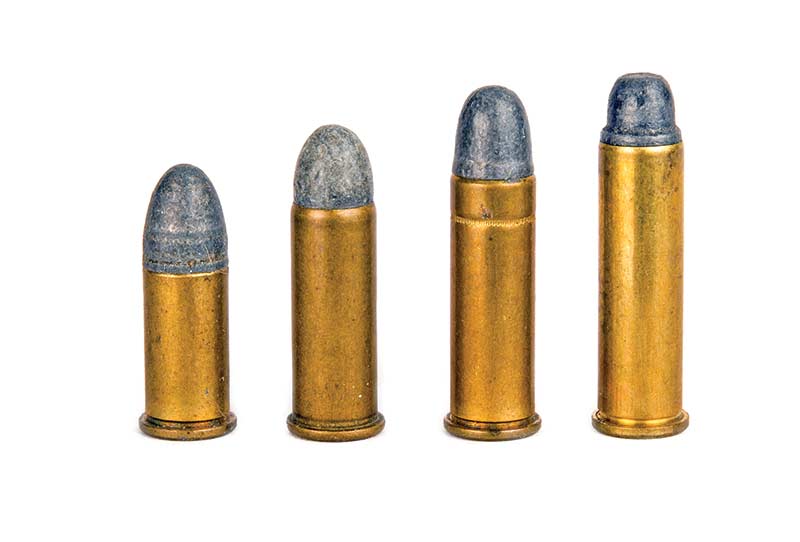If you’ve read my articles much, you must be aware of my quests in which I develop a desire for certain firearms and strive to fulfill it. For example, once, I desired a sample of all S&W Model 20-somethings — including the identical ones with names before the U.S. government decreed S&W had to use model numbers on their handguns. Since only 1,200 S&W fixed-sight Model 21 .44 Specials were made before discontinuance in 1966, that collection was a tough one.
Also, I admit to having an impetuous nature. Yvonne says I’m inclined to jump before looking or, in my case, buy before knowing. Usually, I luck out — such as with the 1913 vintage Colt SAA .44-40 with a 71/2″ barrel — which I bought after seeing a single photo of it. It was a superb find!
Many To Choose …
Not all of my quests have resulted in such sterling results. The .38 Colt SAA central to this article is an example. First, let me give a bit of history. Between 1873 and 1941, Colt SAAs were chambered for no less than 36 different cartridges. Some of these were so similar as to be identical for practical purposes.
For instance, there were SAA calibers stamped “.38 S&W Special” and others marked “Colt .38 Special.” The only real difference was the Colt ones had a definite step in chambers where the 1.16″ long cartridge case mouth seated. The S&W ones had more of a taper there. As for the ammunition, the rounds headstamped S&W had 0.357″, 158-grain roundnose bullets and those headstamped Colt had flatnose bullets of the same weight and diameter. Otherwise, both versions of “.38 Special” SAAs could fire either cartridge. This isn’t too big a factor because before 1941, only 89 of the “Colt Specials” and a mere 27 of the “S&W Specials” were made. This information is taken from the book The 36 Calibers of the Colt Single Action Army by David M. Brown.
More .38 Colt
However, there was another .38 Colt cartridge in this confusion. It began in the 1870s with the cartridge used in Colt’s conversions of .36 percussion revolvers to fire metallic cartridges. It was also one of the introductory rounds in Colt’s Model 1877DA, aka Lightnings. At that time, .38 Colt cartridge cases were about 0.75″ long and loaded heel-type 130-grain, 0.375″ bullets over black powder. Colt began offering .38 Colt SAA revolvers circa 1886. The U.S. Army even adopted swing cylinder double-action Colt .38s starting in 1892. All these early Colt revolvers had barrel groove diameters nominally 0.375″ to accommodate heel-type bullets. The U.S. Army was upset with .38 Colt stopping power and eventually returned to .45s. However, when I fired a black powder powered, 145-grain, .38 Colt into my baffle box, it surprised me by penetrating into the fifth board.
As time passed, ammunition factories realized heel-type bullets were ridiculous. Therefore, they remodeled .38 Colt factory loads to have 1.03″ cases with full diameter 150-grain bullets fitting inside cartridge cases. This necessitated the reduction of .38 Colt bullets to 0.357″ diameter but with deep hollow bases so that when fired, bullets’ “skirts” would expand to grip barrel rifling. This sounds weird today, but it worked well.
Also, it must be noted the barrels in SAA .38 Colts from 1886 to 1914 had 0.375″ barrel groove diameters and chambers bored straight through. Only 1,641 SAA .38 Colt permutations were made in that period. Officially the first .38 Colts became the .38 Short Colt, and the longer ones became .38 Long Colt. However, the Colt factory never stamped anything but “.38 Colt” on their revolvers until the later advent of .38 Specials.

While Duke must use the hollowbase bullet (second from left) in his traditional .38 Colt
revolvers with their 0.375″-barrel groove diameters, he can load all the other solid rounds
for use in his Frankenstein .38 Colt. From left: Lyman #358156HP, Rapine 357-145HB,
Lyman #358477, RCBS .38-158CM and Lyman #358430.
Confused Yet?
Here is more confusion. In 1922 Colt decided to reintroduce .38 Colt to their catalogs. Note that carefully. The guns were stamped .38 Colt, the same as those made between 1886 and 1914 — no “Special” in the name. However, Colt dispensed with the large 0.375″-barrel groove diameter and went to 0.354″ barrel groove diameter, which were their standard for .38/.357. Colt stuck with that 0.354″-barrel groove diameters on their .38s/.357s until revolver manufacture ceased. I have never been able to determine with certainty if the post-1922 SAAs had bored through chambers or if they were cut with a “neck or edge” for the 1.03″ .38 Long Colt case. Brown’s book says Colt made 1,365 of that second run of .38 Colts.
Back To The Quest
If you have managed to understand all of this so far, visualize me virtually wandering into the .38 Colt maze on internet buying sites and factor in my impetuous nature. What I wanted was one of the 1886–1914 .38 Colts. Why would I want to deal with that oversize barrel problem? Because I wanted the education on handloading for obsolete Colt cartridges.
Then, in mid-summer 2020, I spotted a very fine-looking SAA with its 51/2″ barrel clearly stamped .38 Colt. Brothers and sisters, did I jump without thinking, just as Yvonne says I do? By its serial number, the Colt dated to 1899, so it had to have had the large-diameter bore, right? Its nickel plating’s condition was too fine for 121 years old, so I figured it had been restored along the way and obviously, the job had been done professionally. The grips were some sort of silly-looking synthetic material with a big star in the middle of each panel. No sweat there; I’ve discarded lots of grips over the past 50 years.
When the .38 Colt arrived, I was more than pleased upon unpacking it. The nickel finish was unmarred in any way. When the grips were removed, I found stamped there “9-8-5 N” on the left side of the trigger guard. To me, it was a code of whoever restored this revolver with “N” standing for nickeled. My pleasure was short-lived. A 0.357/0.358″ bullet will drop right through a 0.375″ bore. One did not slide through this Colt’s bore. Slugging it resulted in a 0.354″ piece of lead, so obviously, this Colt’s barrel was post-1922. I sent for a factory letter before even shooting it.
Things Get Interesting
Initial shooting is when more evidence of my blunder appeared. After the first shot of .38 Long Colt factory ammo, the cylinder would not rotate. I had to dismount it, which revealed the firing pin hole in the frame had been wallowed out to the point primers extruded into it. That’s not good at all. When I looked into chambers, they were “necked,” but a glance showed they were much too long for the 1.03″ .38 Long Colt’s case. In fact, they would even accept .357 Magnum cases. Then I spotted a number on the cylinder. Most SAA cylinders have at least part of their frame’s serial number. This one’s didn’t match the frame and it had an M-prefix. So, I checked my Colt SAA .357 Magnum’s cylinder, which was made in 1969. It also has an M.
Needless to say, I was upset, for this revolver was sold with a “no return” policy and cost thousands — not hundreds. It needed salvation, so it was quickly packaged up and sent to my friend Bill Fuchs dba as Spring Creek Armory in Ten Sleep, Wyo. The firing pin hole was wallowed out, but it had also been shoddily converted from a rimfire firing pin hole. That was the bad news, but the good news was Bill could weld it so the Colt was functional again. I also told him to fit it with some nice one-piece style grips while it was there.
Franken-Colt
Then the Colt letter arrived and it certainly did not improve my mood. This Colt shipped from the factory in 1899 as a .38 WCF (.38-40) with a 71/2″ barrel. So, it started as a centerfire, was converted to a rimfire and then reconverted to a centerfire. And along the way, someone had fitted it with a .38 Colt barrel and Colt .357 Magnum cylinder and then had been renovated by someone else. My impetuous nature had netted me a Frankenstein Colt! Albeit a very handsome one.
When it returned from Spring Creek Armory, it sported a beautiful set of rosewood grips. Furthermore, it functions perfectly and shoots both accurately and to its sights. It eased the pain somewhat. I’ll never get back from it the bucks that went into it, but it’s a very eye-catching Colt six-shooter. And at least it’s easy to handload for. For my other .38 Colts, I load hollowbase bullets because of their 0.375″-barrel groove diameters. Those loads will work just fine in this revolver. And, seeing as how it will accept any .38 Special bullets for which I have a plentitude of molds, reloading for it will be a cinch. So, this Frankenstein Colt will stay with me.
Someday if anyone asks what I’m shooting, I’ll tell them to look right there on the barrel; it’s a .38 Colt!
